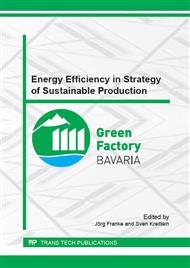p.154
p.162
p.171
p.180
p.187
p.196
p.205
p.213
p.223
Energy Demand Simulation of Machine Tools with Improved Chatter Stability Achieved by Active Damping
Abstract:
The electric base load of milling machine tools has a high share of the machine’s total energy consumption. An approach to decrease the energy demand per workpiece is to shorten the machining time by raising the material removal rate. The maximum feed depends on the tool’s wear resistance while the maximum depth of cut is often limited by the chatter stability of the machine. In this paper active damping is used to damp chatter vibrations, which leads to a higher depth of cut. To evaluate the decrease of energy consumption for any workpiece, a modeling methodology for the energy demand of machine tools was developed, which is presented in this paper. The methodology is able to estimate the energy requirements of the spindle during cutting, of the feed drives, of the auxiliary equipment and of the base load. The numerical results were experimentally validated by different 2.5D machining processes, with good agreement between the simulation model and the experimental results. Therefore, the proposed methodology can be used effectively for calculating the total energy required for the machining of any workpiece. In addition, the structural dynamics of the machine tool, the active damping system and the cutting process were modeled in order to simulate the chatter stability. This enables a straightforward determination of the optimum cutting parameters as well as a comparison of different milling part programs, both in terms of the energy demand. Furthermore, it is possible to evaluate the energy conservation by active damping and to point out for which cutting processes active damping is useful.
Info:
Periodical:
Pages:
187-195
Citation:
Online since:
November 2015
Authors:
Keywords:
Price:
Сopyright:
© 2015 Trans Tech Publications Ltd. All Rights Reserved
Share:
Citation:


